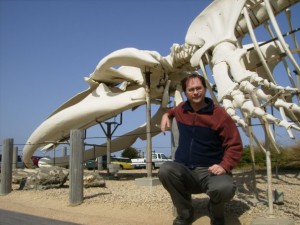Blue Whale Size : Even bigger than the biggest dinosaur, the blue whale grows to about 30 metres (about 100 feet) long. They are believed to weigh in at 180000 kg (almost 400000 pounds) – about the same as a Boeing 747-400 ready for takeoff – but weighing such a huge animal is very difficult to do. Most measurements were made during the era when they were hunted – hunters would cut the whale up into pieces and weigh each piece separately. This always gives a smaller-than-true figure for its weight.
Blue Whale Amazing Facts : Its tongue is as big as an elephant – wide and long enough for 50 people to stand on! It’s heart is the size of a small car. Even at birth, they weigh almost as much as 20 adult humans!
Blue Whale Information : The blue whale is a type of baleen whale – baleen whales don’t have teeth in their upper jaw, instead they have a baleen – something like a comb – which they use to filter their food from the water. They are in fact Rorquals, which as well as a Baleen, have very flexible folds of skin running from their mouth to their bellybuttons. This allows them to open their mouths very wide, and take in massive amounts of food with each gulp.
Since Blue whales are Baleen whales, it follows that as well as being the world’s largest animal,
- The world’s largest Rorqual is the Blue Whale,
- The world’s largest Baleen Whale is the Blue Whale,
- The world’s largest Cetacean is the Blue Whale (the Cetaceans include whales, porpoises and dolphins),
- The world’s largest Mammal is the Blue Whale, and
- The world’s largest Vertebrate is the Blue Whale.
The Scientific Name for the Blue Whale is Balaenoptera musculus. Balaenoptera means “winged whale” (The word Optera means wings in Latin). They don’t really have wings! However, they have very large side fins. What about musculus? It’s Latin for “muscular”, and also for “mouse” – yes, the largest animal ever was called the mouse whale, as a joke by the scientist who named it!
Blue Whale Habitat : The whole sea is their home. Note that whales are mammals, not fish! So they breathe air just like us, and give milk to their baby whales – about 400 litres (100 gallons) every day. The blue whale, like all whales, must come up to the surface regularly to breathe. They can hold their breath for about half an hour, but they never swim far from the surface. In the late 19th and early 20th century (until the 1970’s), men took advantage of this to hunt these whales. It is estimated that now there are only about 5000 to 12000 blue whales in the whole world. Before hunting began, there were more than 100 times this number. Even now, the whales struggle. Once upon a time, a whale could hear a friend calling from as far as the opposite side of the world. Now, modern ships have made the ocean noisy place, and it’s getting noiser and noiser every year. This is making it harder and harder for the whales to socialise, and may be why their population has not gone up much since hunting stopped.
Blue Whale Diet : Blue whales, despite being so large, in fact eat very small shrimp-like animals, called Krill. These typically grow to about 1 or 2 cm long. Evidently, the blue whale must eat a great many krill every day to survive! It does this by swimming to a place with many many krill, taking a big gulp of water, and then pushing the water out of its mouth through the Baleen. The krill are trapped in its mouth, and then swallowed.
Blue whales can swim at speeds of up to 50 kph (30 mph), but normally cruise at less than half that. When eating, they swim very slowly indeed, only about 5 kph (3 mph). Normally they live alone or in pairs, and it is believed they can live for up to 80 years.
Blue Whale Pictures : It is hard to get photographs of Blue Whales, since they are extremely rare creatures. The skeleton in the photograph above is on display at a marine research centre in California, a mile or so away from where the blue whale washed ashore.

